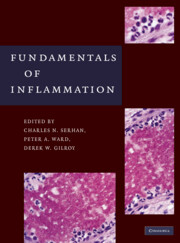Book contents
- Frontmatter
- Contents
- Contributors
- Preface
- PART I THE INFLAMMATORY RESPONSE – AN OVERVIEW
- PART II INDIVIDUAL CELL TYPES
- PART III CHEMICAL MEDIATORS
- PART IV IMMUNOPHARMACOLOGY
- PART V INFLAMMATORY DISEASES/HISTOLOGY
- PART VI ANIMAL MODELS OF INFLAMMATION
- 27 Models of Acute Inflammation – Air-Pouch, Peritonitis, and Ischemia-Reperfusion
- 28A Experimental Models of Glomerulonephritis
- 28B Glomerulonephritis and Ischemia Reperfusion Injury
- 29 Asthma
- 30 Animal Models of Rheumatoid Arthritis
- 31 Ocular Inflammation Models
- 32 Atherosclerosis in Experimental Animal Models
- 33 Oral Inflammation and Periodontitis
- 34 Pathogens and Inflammation
- Index
- References
28B - Glomerulonephritis and Ischemia Reperfusion Injury
from PART VI - ANIMAL MODELS OF INFLAMMATION
Published online by Cambridge University Press: 05 April 2014
- Frontmatter
- Contents
- Contributors
- Preface
- PART I THE INFLAMMATORY RESPONSE – AN OVERVIEW
- PART II INDIVIDUAL CELL TYPES
- PART III CHEMICAL MEDIATORS
- PART IV IMMUNOPHARMACOLOGY
- PART V INFLAMMATORY DISEASES/HISTOLOGY
- PART VI ANIMAL MODELS OF INFLAMMATION
- 27 Models of Acute Inflammation – Air-Pouch, Peritonitis, and Ischemia-Reperfusion
- 28A Experimental Models of Glomerulonephritis
- 28B Glomerulonephritis and Ischemia Reperfusion Injury
- 29 Asthma
- 30 Animal Models of Rheumatoid Arthritis
- 31 Ocular Inflammation Models
- 32 Atherosclerosis in Experimental Animal Models
- 33 Oral Inflammation and Periodontitis
- 34 Pathogens and Inflammation
- Index
- References
Summary
INTRODUCTION
The kidney receives disproportionately high blood flow, Blood flows to each renal filtering unit, known as the nephron, through a specialized vascular bed called the glomerulus, which is by design uniquely leaky to solutes and plasma proteins (Figure 28B.1). Human glomeruli filter 144 liters of plasma filtrate a day from the bloodstream (Figure 28B.2). Disruption of the glomerulus interferes with blood flow to the downstream segments of the nephron due to the presence of a second capillary network deriving from the glomerular capillaries, frequently culminating in ischemia of the nephron, with consequent chronic inflammatory responses to ischemic injury of parenchymal cells. Furthermore, the unique regulation of vascular tone in the kidney paradoxically can worsen ischemic insults by triggering vasoconstriction. Physiologically, compromised blood flow in the medulla of the kidney is a prerequisite for effective reabsorption of ≈142 liters a day of filtered solute back into the blood compartment, but renders the high-energy-requiring components of the medulla especially susceptible to ischemic injury.
The glomerulus is particularly prone to inflammatory injury, perhaps due to the tendency of immune complexes and other abnormal proteins to become lodged in the specialized filtering basement membranes, which then trigger immune responses not seen in other regions of the vasculature. Rarely autoimmunity directed at unique proteins within the specialized glomerular filtering membranes also triggers stereotyped responses in the glomerulus, which we now recognize as immune cell and parenchymal cell responses to injury.
- Type
- Chapter
- Information
- Fundamentals of Inflammation , pp. 349 - 375Publisher: Cambridge University PressPrint publication year: 2010



